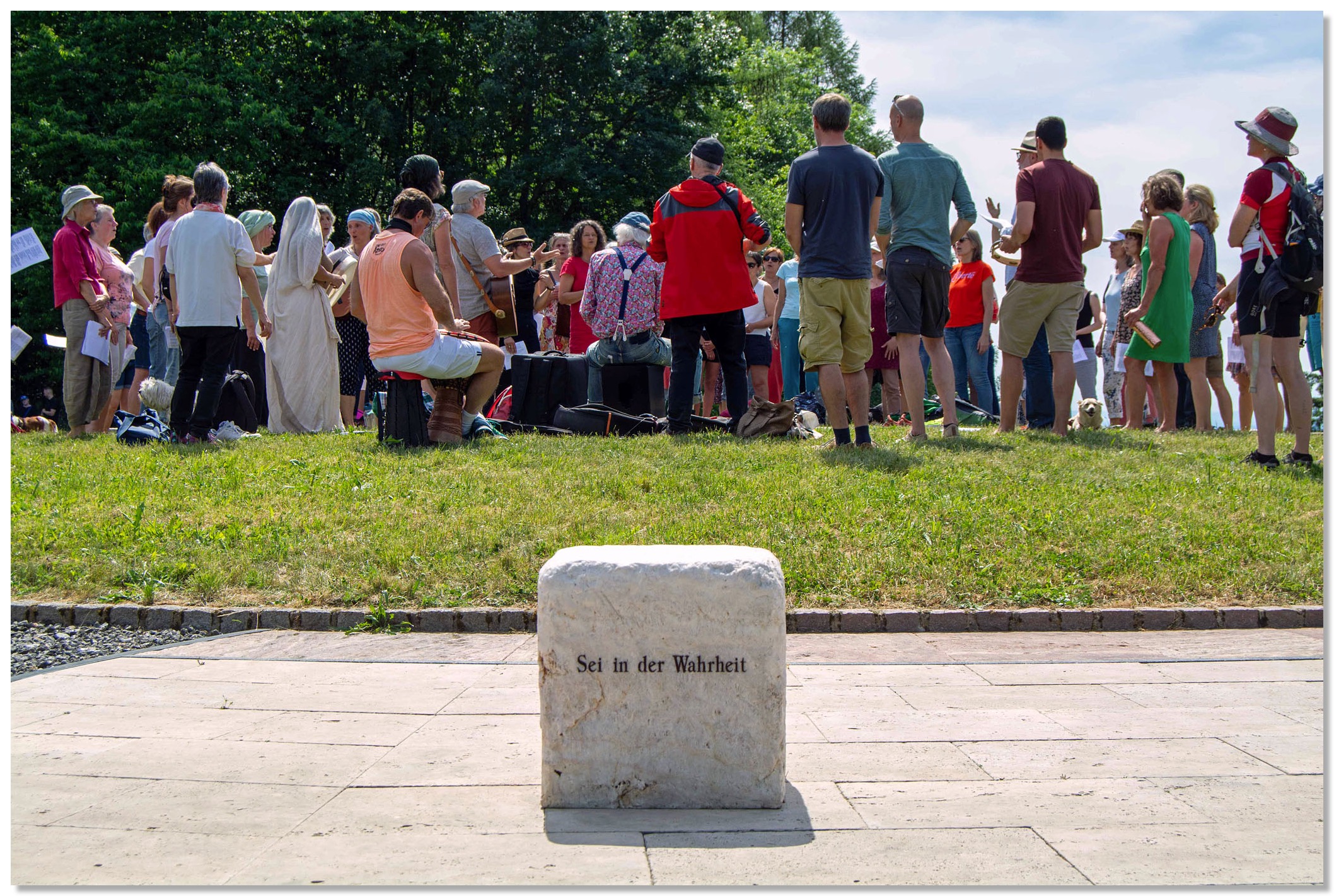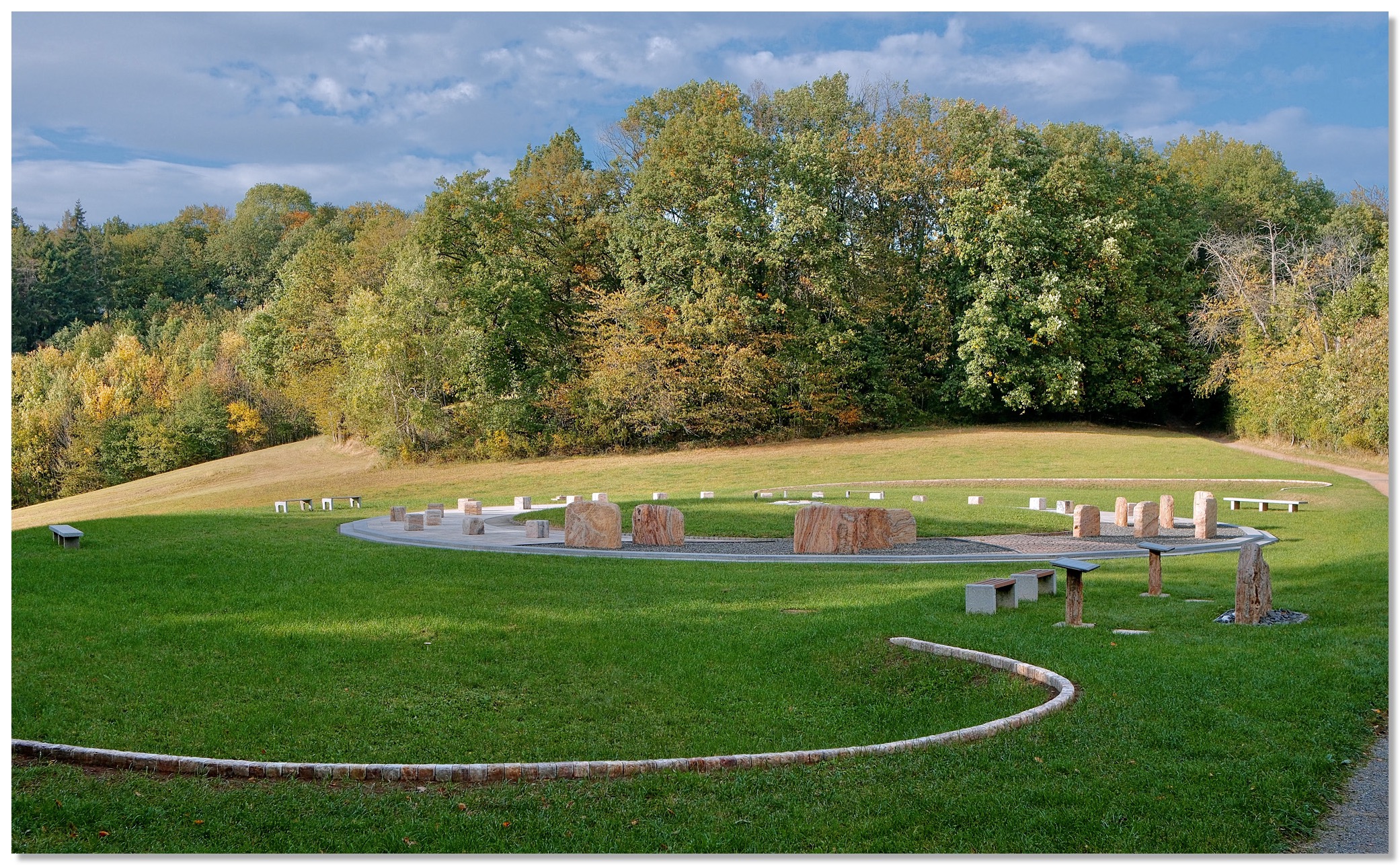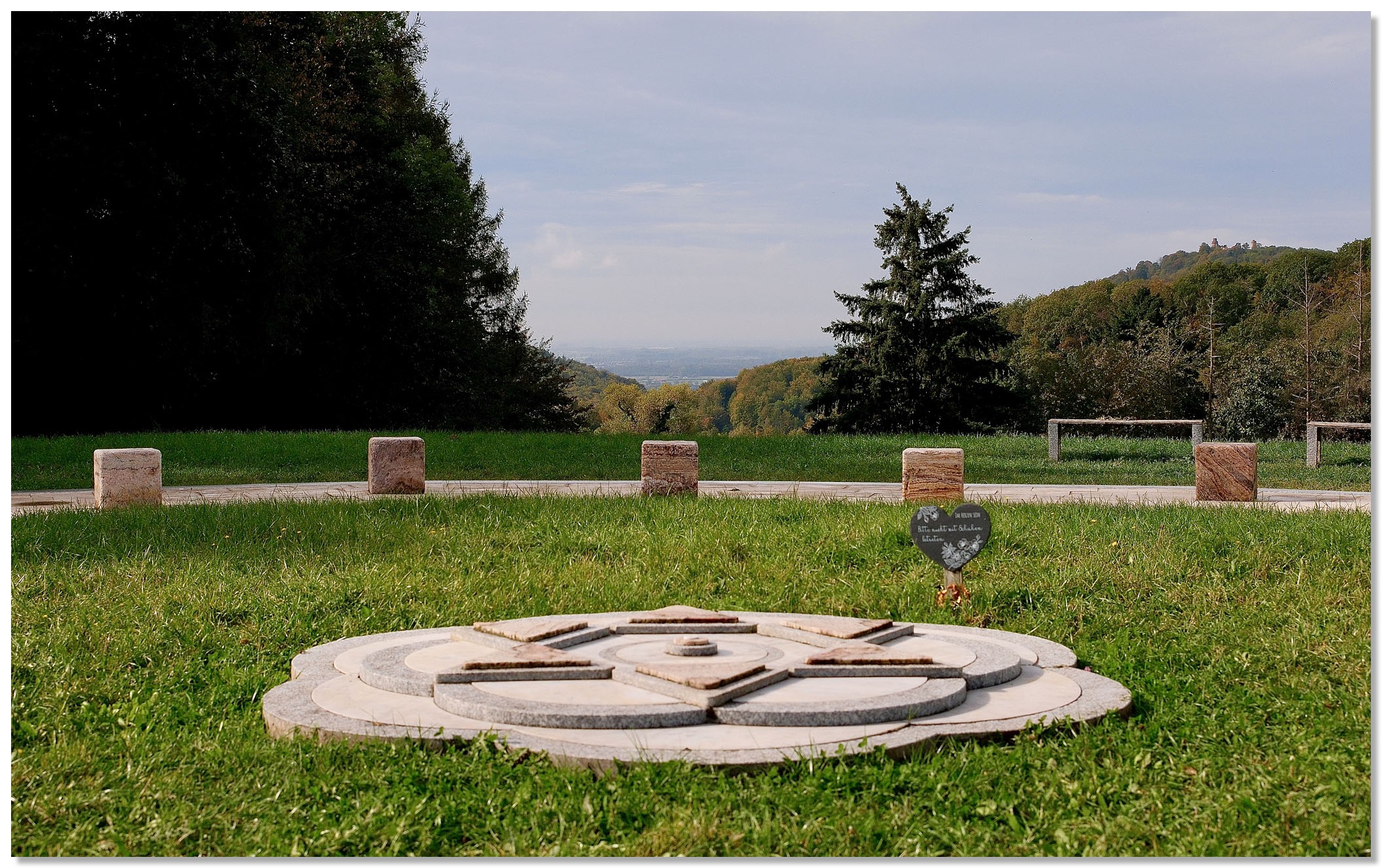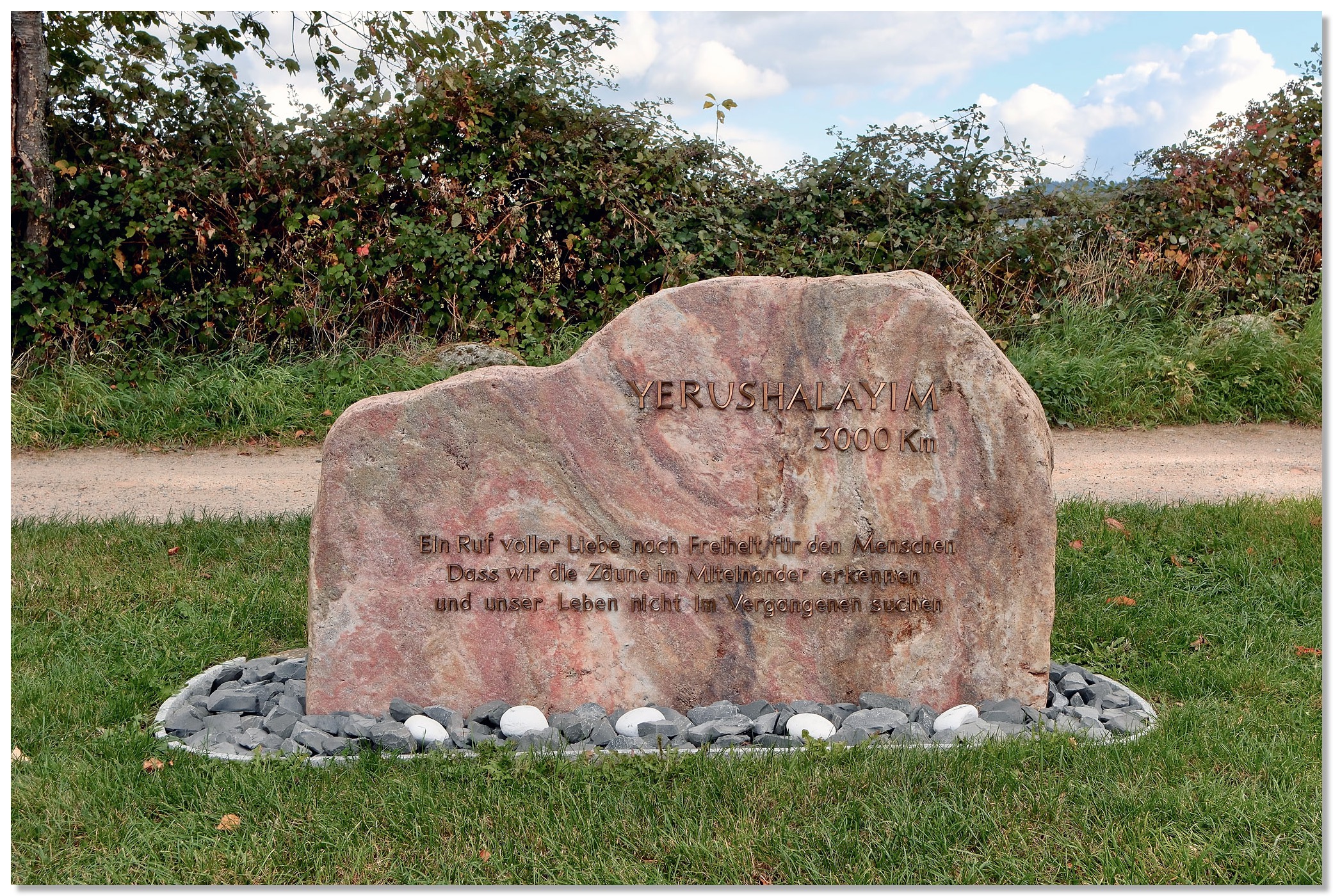Discover the peace within you, change the world around you
A Symbol of Reconciliation: A Symbol of Reconciliation: In our world often marked by conflicts and misunderstandings, the need for reconciliation among people with their diverse life philosophies, cultures, and belief systems becomes increasingly apparent. Reconciliation becomes possible through love and freedom in our own inner being. This newly found peace is a state of consciousness where old wounds can heal and bridges to a shared new understanding can be built. The Peace Monument stands as a symbol of this healing process, which finds fulfillment not only in the encounter with ourselves but also in the encounter with others, thereby reflecting back on our own essence. 'All real living is encounter,' as Martin Buber stated in 'I and Thou.', Heppenheim, 1923. This quote emphasizes the importance of dialogue and encounter as the path to true reconciliation and peace.Liberation from within: The Friedensmal (Peace Monument) serves as an inspiration for individuals, where based on ethical principles and personal responsibility, inner healing and conscious commitment to the community combine into a benevolent action. Simultaneously, it encourages freeing oneself from the chains of ideological illusions and growing in dignity, to lead a life of freedom as a mature individual. It is a deep bow to the rich heritage and the light of the cultures of humanity - including one's own culture - and it makes us aware of the responsibility associated with this heritage. The Friedensmal, as a universal symbol of peace, acknowledges and honors the interconnectedness of all souls in the fabric of life..
I. A path of Healing and Freedom
The Friedensmal, which is designed in the language of form of the Christian-Jewish tradition and thus was inaugurated as the 'Jerusalem Friedensmal', serves as a guide to reconciliation. It opens a space for healing and freedom and invites all people, regardless of their origin or religious belief, to embark together on the inner path of peace. It is a path of unfolding our true being. Our being constantly shapes the values we carry into the world and from which we - often unconsciously - live and act.
We heal our country and this world within ourselves.AWAKENING - Confronting the suffering of German history, born out of ideological blindness, is a vital part of Germans' engagement with their past. The Friedensmal broadens this perspective, acknowledging that suffering and delusion are not limited to one nation or era but represent a global phenomenon. Addressing human delusion requires a profound process of working through, which goes beyond mere remembrance and leads to a significant paradigm shift: Memory work, understood as an integral part of spiritual development, thus becomes a crucial aspect of both individual and collective spiritual journeys.
This shift in consciousness shows that genuine healing, extending beyond historical reflection, requires a sufficiently large collective awakening to transform the roots of suffering and prevent the mistakes of the past from repeating. The path to true peace, whether with the German past or with global conflicts, is a central step in this process. The Friedensmal serves as a symbol and a source of inspiration for the process of healing and awakening.
 Inauguration of the '22 Stones for a New Togetherness' in the Friedensmal.HEALING - In the Friedensmal, there is an approach to trauma processing that differs from traditional methods and offers a universal perspective. While a direct focus on trauma, as often found in dealing with the past, can be counterproductive, the Friedensmal emphasizes the 'structure' surrounding the trauma – that is, the disturbed perception and assessment capabilities. This perspective highlights the importance of processing the consequences of trauma and adjusting behaviors. This approach acknowledges that healing is often an indirect process, occurring through the strengthening and organizing of the surrounding 'tissue' – our communities and healthy social structures. By doing this, it releases the trauma from its hold, facilitating its resolution and transformation.
Inauguration of the '22 Stones for a New Togetherness' in the Friedensmal.HEALING - In the Friedensmal, there is an approach to trauma processing that differs from traditional methods and offers a universal perspective. While a direct focus on trauma, as often found in dealing with the past, can be counterproductive, the Friedensmal emphasizes the 'structure' surrounding the trauma – that is, the disturbed perception and assessment capabilities. This perspective highlights the importance of processing the consequences of trauma and adjusting behaviors. This approach acknowledges that healing is often an indirect process, occurring through the strengthening and organizing of the surrounding 'tissue' – our communities and healthy social structures. By doing this, it releases the trauma from its hold, facilitating its resolution and transformation.The Friedensmal serves as a symbol and source of inspiration for this subtle, profound healing process, encompassing both personal development and collective coping with the past on a global level. It supports the idea that focusing on the reactions and behaviors triggered by trauma – regardless of their origin – can be an effective path to healing. The Friedensmal connects diverse cultural and spiritual paths with a universal symbolism. This underscores the holistic healing approach of the monument, thereby opening the scope of global consciousness for local past coping and personal development.
CONSCIOUSNESS - If our goal is peace, not only with our past but also in our present and future, then this is inseparably linked with the unfolding of a new consciousness. By moving away from a perspective focused exclusively on trauma and acknowledging suffering as an inevitable, shaping experience in our life's journey, we open ourselves to new, illuminating beliefs, ways of thinking, and behaviors. This perspective, which understands healing not as mere 'repair' of remembered traumas but as the overcoming of limiting patterns, leads to a concrete, effective spirituality that enables genuine healing and deep reconciliation on both an individual and global level.
SPIRITUALITY - The core message of the Friedensmal, consciously designed as a symbol of hope and new life rather than a memorial, is the promotion of peace and freedom. This symbol of change invites us to delve deeper into ourselves and live in harmony with the values of love, peace, and freedom. It marks the beginning of a journey into a new world, at the core of which lies culture and, in particular, art. It is the journey into a metaphorical 'new Jerusalem', rooted in the heart of our spiritual awakening – a state of peace and harmony that includes all people. By recognizing and accepting the ego, we open up the possibility of transcending it and using it positively in our lives in this world. Thus, we can gain the freedom to again have healthy relationships that enrich our existence and sustainably shape the cultural fabric in which we live.
 The Jerusalem Friedensmal on the European Long Distance Path E8 in South Hesse.
The Jerusalem Friedensmal on the European Long Distance Path E8 in South Hesse.II. The Emergence of a New WE
ENCOUNTER - The 'Stone of Encounter' on the hiking trail and the 'Tree of Life' at the heart of the monument are powerful symbols. At the 'Stone of Encounter', the conscious handling of personal and collective boundaries is addressed. This involves first recognizing them. We reflect on their significance in our lives and in relationships. By understanding, respecting, and questioning our boundaries, we open a space for honest dialogue and deep, authentic encounters. The 'Tree of Life' represents not only the intertwining of the material and spiritual worlds but also illuminates our oneness with the source of all life. This connectedness also reminds us of our shared responsibility for each other. Genuine encounters, fostered by places like the Friedensmal, are essential for individual well-being and key to bridging societal divides. They nurture the understanding and harmony needed to collectively overcome the challenges of our times.SOCIETY - The Friedensmal emphasizes the importance of a positive identification with one's own culture, which not only offers a sense of belonging but also strengthens our awareness of our role and responsibility in the global community. Those who are deeply rooted in their cultural heritage gain the courage and strength to open themselves to not only other people but also other cultures, and to actively and warmly participate in social life. Like a tree, that can only thrive with healthy roots, cultures draw their vitality from their rich heritages. German culture is still deeply rooted in its Jewish-Christian heritage, which has shaped it for over a thousand years. In this context, the Friedensmal acts as a reconciling and healing symbol, embodying Shalom in the relationship with Judaism. In this regard, the Friedensmal stands for reconciliation, healing, and appreciation not only among people but also between different nations and cultures. Thus, it represents the hope and vision for a new world.
 Blossom of Life - Symbol of Interreligious Spirituality at the Center of the Friedensmal
Blossom of Life - Symbol of Interreligious Spirituality at the Center of the Friedensmal
III. An Interreligious Understanding
TRANSZENDENCE - The Friedensmal symbolizes the journey of spiritual seeking and understanding. Life and death, injury and healing, captivity and freedom are ultimately all manifestations within this larger framework. The message of the Friedensmal distances itself from the notion of a divine power ‘in the heavens’ controlling the world and humans, and instead brings the responsibility back to the human level. This does not signify a separation from God - on the contrary - it recognizes that humans are in God and God is in them. This understanding of God, far from human concepts of power and control, reveals itself as a mystical experience and demands humility from those who believe they know.
DIAOLOGUE - In the context of interreligious dialogue, the Friedensmal fully unfolds its meaning as a place of universal mysticism, where it does not deny its roots in the Christian-Jewish tradition but rather uses them as a starting point for a broader understanding. It invites one to penetrate the specific language of form of our christlich geprägten culture while simultaneously discovering the universal truth that connects all spiritual paths.
This creates a space where people of different religions and beliefs have the opportunity to look beyond the boundaries of their own traditions. The Friedensmal becomes a meeting point where a deeper connection with the universal message of mysticism is established and mutual understanding is fostered. It serves as a bridge between various spiritual paths, thereby enabling the recognition of commonalities and learning from the rich experiences and insights of others.
BOUNDARIES - Not only in the physical and social realms do boundaries exist, but also within our belief systems and ideologies. Often unconsciously, they shape our viewpoints and relationships. A crucial step on our spiritual journey is to recognize and question our own religious and ideological boundaries. This self-reflection allows us to deepen perceptions within our own belief system, as well as to broaden our perspectives and develop a deeper understanding of other worldviews and faiths. Awareness of our own limits is essential for growing beyond them. This realization leads to a rich, comprehensive spiritual understanding and opens us up to deeper insights into a spiritual unity found in many religions, which connects us all.
 The 'Stone of Encounter' on the hiking trail at the border of the Jerusalem Friedensmal
The 'Stone of Encounter' on the hiking trail at the border of the Jerusalem Friedensmal
IV. Beyond Ideological Boundaries
ONENESS - The idea of the spiritual unity of humanity is reflected in the Friedensmal by making it experiential that religious narratives and symbols often serve as metaphors for deeper spiritual truths. They attempt to put the unfathomable into words, turning understanding into a continual process of growth and learning. The Friedensmal is therefore not just a physical memorial, but also a symbol for the universal process of spiritual awakening. It encourages us to think beyond our own ideologies and limited perspectives, and to engage in free dialogue with a deeper inner understanding.
As we evolve our interpretations and conceptions, we open ourselves to a more comprehensive dimension of being and connectedness that encompasses all spiritual traditions and paths. This pursuit of knowledge and awareness of our own limitations are the gateways to the Friedensmal - we cross the Threshold of Humility it embodies. It invites us to be part of a constantly unfolding dialogue with life and to collectively build a symbolic 'New Jerusalem' - a state of deeper spirituality, truthfulness, and reason. This especially means today the (self) liberation of humanity from an ideological delusion - represented in the Friedensmal by the Dark Ring of the alienated mind, broken through by the Tree of Life.
This particularly means the (self)liberation of humanity from the prevailing ideological madness of today - represented in the Friedensmal by the Dark Ring with its 11 'gravestones', broken open by the Tree of Life.
Recognizing the deeper spiritual truths allows us to look beyond simplistic enemy images and to invest our life force in building positivity within ourselves, instead of directing it towards external circumstances that we can not change and perceive as negative. In a non-dual world of polarities, it is often not the 'against' which presents the real problem, but rather the lack of an internalized 'for', which guides and strengthens us and our community. The non-duality of the world signifies a connectedness that transcends all polarities and unites us at the deepest level of our being.

Embark on a journey…
Summary: The symbolism of the Friedensmal encourages us not only to appreciate the rich history and tradition from which it originates but also to open our eyes to the comprehensive, universal dimension of our spiritual quest. While the monument represents a significant change in dealing with the past – including German history, characterized by suffering, guilt, and responsibility – it places this within a broader, profound spiritual context.
The Peace Monument illustrates that the causes of many historical misdeeds and sufferings can be found in a lack of awareness and clinging to limiting ideologies, presenting a universal challenge. Liberation from these bonds opens a path to genuine understanding and peace that encompasses all cultures and traditions.
Therefore, the Friedensmal symbolizes not only the healing approach to our own past but also the ongoing development of our understanding of the transcendent. It demonstrates that true spiritual development – exemplified in agape, the selfless love – is essential to overcome the mistakes of the past and promote a peaceful coexistence. Thus, the Friedensmal symbolically represents a path to life that brings together all people, regardless of their religious affiliation or cultural background, in a common process of spiritual development and reconciliation.
🇩🇪 🇬🇧 Switch
Questions that prompt reflection
How can the symbols and spatial design of the Jerusalem Friedensmal inspire us to actively seek peace, understanding, and shared responsibility in our own lives and in our communities?In what way can the experience of the Friedensmal encourage us to reflect on our own cultural roots and place them in a larger context of global interconnectedness and the common human pursuit of peace and harmony?
